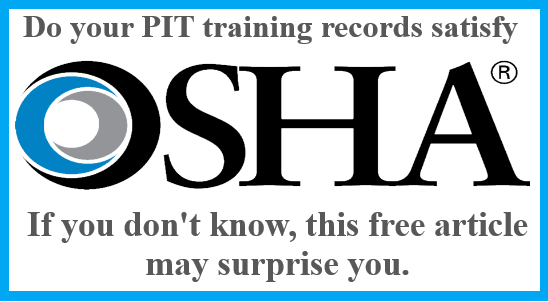Most businesses that employ the use of lift trucks have many other pressing things to worry about aside from PIT training paperwork. Still, whether it is for OSHA compliance, or to acquire insurance, it is required and must be correct.
The requirement for proof of “certification” is simple, and it goes without saying [mostly] that the “proof of certification” is not the important part, but the actual training is. That is easy to miss, and all too often it is.
More often missed is the simplicity of the requirement for maintaining training records for the PIT program, which is likely what OSHA is going for in the policy below:
Certification. The employer shall certify that each operator has been trained and evaluated as required by this paragraph (l). The certification shall include the name of the operator, the date of the training, the date of the evaluation, and the identity of the person(s) performing the training or evaluation.
To expound on the above policy, we will start with what is not there, and that is a “wallet card” or an “8×11 paper certificate”. This is important because the idea that wallet cards or paper certificates are required often blinds administrators and trainers to what is needed.
If wallet cards and certificates are how records are kept, that is acceptable if they are accessible when needed. In other words, if they are left at home, or lost, and there is nothing else to support the needed information, then the training never happened. On the other hand, it’s easy to see how the situation will look when you need to present proof and there are clear and easily accessible records to show an unlikely auditor.
Something else that is not listed in the requirement but is covered in other policies is the location of training and the classes of trucks that the operator was certified to operate. The location of training, depending on who’s asking, is important because of the “workplace topics” issue. If the training was done off-site then there is a potential for ss the policy says, “the employer shall certify that each operator has been trained & evaluated”.
The Class of PIT is not listed as something on the certification, but, if an operator was trained on Class 4 PITs, and is operating an Order Picker, then the training does not match the equipment being operated. Not only that but if an accident was caused by a PIT that wasn’t something the operator was trained on, then the lack of training could be construed as the cause of the accident. This takes us back to the priority of training, which is to prevent accidents. It’s a different story if proper training was done and it can be proven that if training was done off-site, without proper certification, or on the wrong equipment, and no proof otherwise.
What OSHA requires, and with good reason, is effective training, and tracking. The top priority of training is to prevent injury and death, and that is the real reason that OSHA-compliant records should be kept. Not because they are OSHA complaints, but because it’s how you keep track of training and retraining, which is a precursor to effective training. In other words, a lack of records is a lack of training, and a lack of understanding of correct record-keeping wreaks of misaligned priorities to auditors, and operators.
To keep it simple, keep a record of the training the operators have had the way the policy above prescribes, where it can be easily accessed. Then, ensure there is a way to reschedule training for the operators at their corporate or OSHA-required period, calendar invites have been the most effective way of doing this. Whatever you do, don’t rely on anything other than well-kept records.
In the next article, we will discuss “who” can, and should do training.
By Dustin Link






